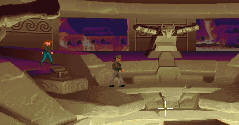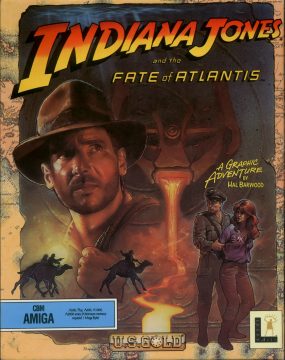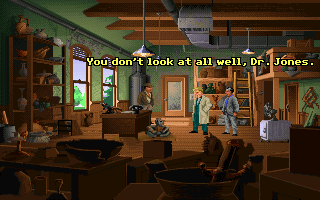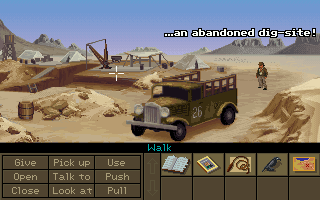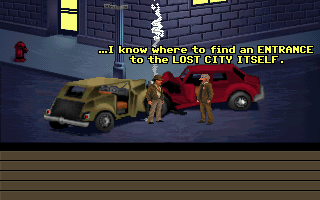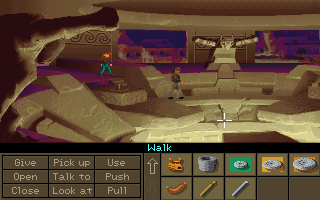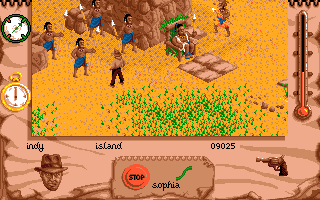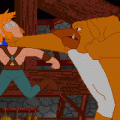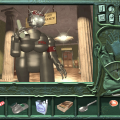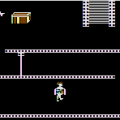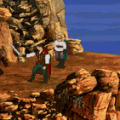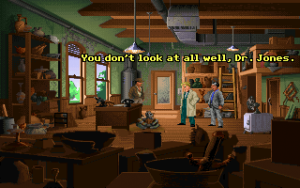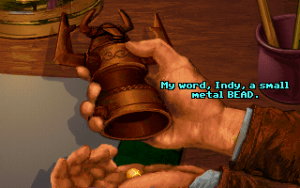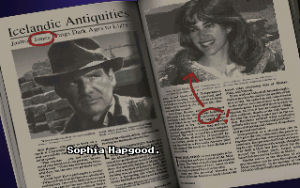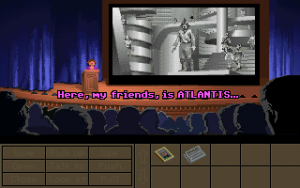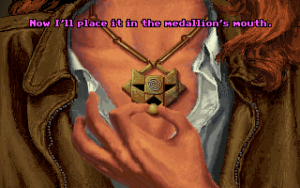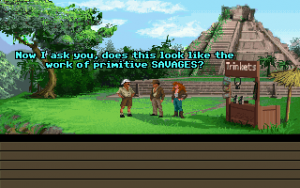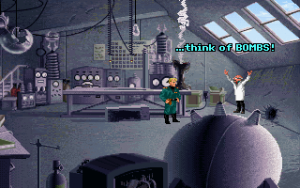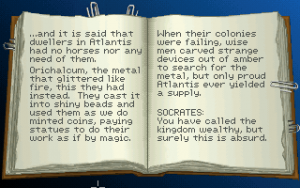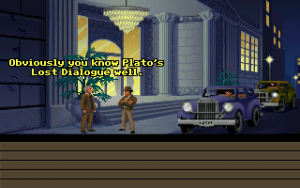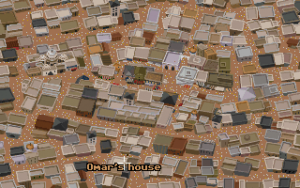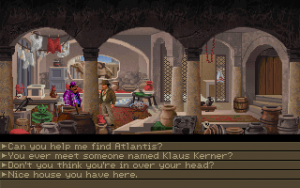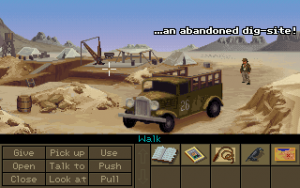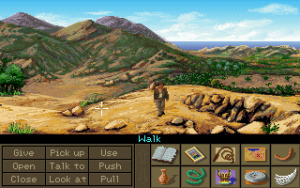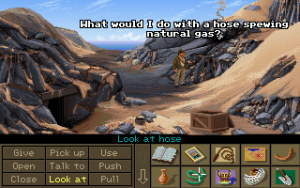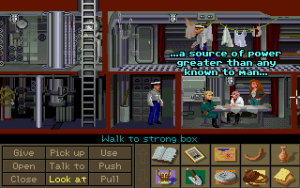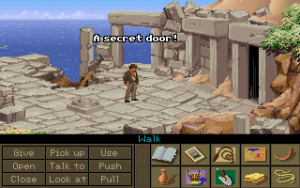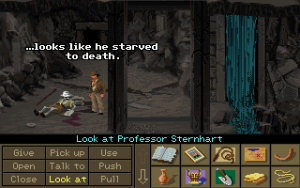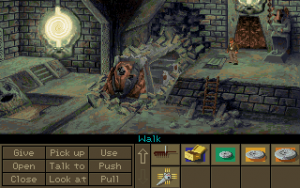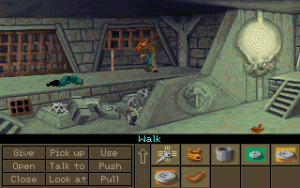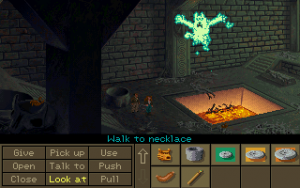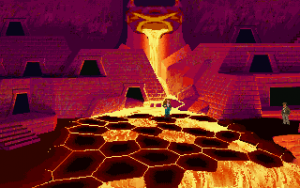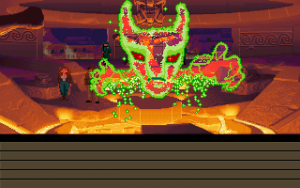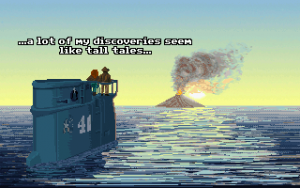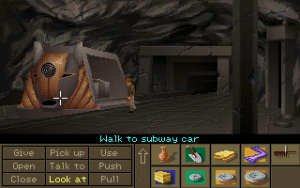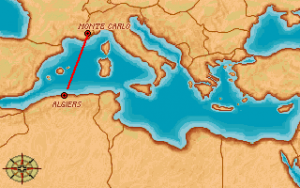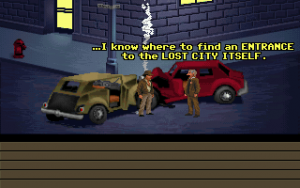- Indiana Jones and the Last Crusade: The Graphic Adventure
- Indiana Jones and the Fate of Atlantis
LucasArts continued to develop awesome graphic adventures after The Last Crusade was declared a hit film and game. In 1990, after the modest success of the underrated fantasy adventure Loom, LA set the bar for graphic adventures with their seafaring smash hit, The Secret of Monkey Island; its sequel, Monkey Island 2: Lechuck’s Revenge, would be released one year later. The hilarious adventures of wannabe pirate Guybrush Threepwood gained much acclaim and placed LucasArts as one of the foremost Western developers of the early 1990s. This was decidedly impressive for a budding game company branched off from a film producer! However, it had not forgotten about the films that indirectly led to its creation, and in 1992, Noah Falstein teamed up with cinematographer-turned-writer for LucasArts, Hal Barwood, to release an all-new Indy adventure in virtual form, Indiana Jones and the Fate of Atlantis. Widely considered to be the hottest Indiana Jones property not based on any of the films, The Fate of Atlantis was hailed as another success for the point-and-click adventure genre.
The adventure kicks off with the opening credits showing through an interactive intro sequence played purely for slapstick, fitting in perfectly with the series’ unique blend of action and comedy. The year is 1939, one year after The Last Crusade, and while the dark shadows of Nazi rule loom over Europe, our man Indy is clumsily stumbling about the various artifact rooms in the Barnett College museum. He is searching for a small statue at the request of a Mr. Smith, an ominous man who just so happens to be tall, blond-haired, and blue-eyed. Indy finds the statue and brings it to his office where Marcus Brody and Mr. Smith are waiting. Smith claims he has a key that fits into the statue, and this key indeed opens up the statue’s base to generate a small gold-colored bead. Smith pulls out a gun and forcibly takes the statue and bead, but while waiting for his getaway car, Indy leaps forth and fights the bastard. The bad guy flees, but Indy manages to remove his coat in the struggle and rummage through his pockets for some information.
The German’s true identity is Klaus Kerner, an agent for the Third Reich. Marcus pulls out another item from the coat, an old issue of National Archaeology that highlights Indy’s first big job; an expedition into Iceland with Sophia Hapgood, Indy’s assistant for the, whom he describes as “a snobbish rich brat from Boston.” She gave up archaeology to become a psychic, obviously not a profession Indy approves of, although she is also the foremost authority on Atlantis. Marcus realizes that if Kerner could track down Indy, he might know where to find Sophia as well. Indy agrees and goes to New York City, Sophia’s current residence, for two reasons. (A): Indy’s a good guy, and even if he does not have a high opinion of Sophia, he’s obligated to save the annoying woman (a trait Indy proved with Willie in Temple of Doom). And (B): If he finds Kerner in New York, he might find out more about the bead in the statue and the evil reasons behind the Nazi’s motivation to acquire it. Whatever it is, it can’t be a damn bit of good!
This is the setting for the stage of an incredible adventure which is pure Indiana Jones all the way through. It may not be based on a film like The Last Crusade, but the setting and plot of The Fate of Atlantis would be good enough to have a film based off of it. If anything, the fact that the game is an entirely new adventure works to its advantage, as it directs an original story for which it has more freedom than can be allowed for two hours of cinema. It’s a decent plot too, just what you’d expect from an epic Indy adventure. The magical MacGuffin this time around is Orichalcum, a mystical metal purported to harness far more energy than any radioactive element; the object Indy finds in the idol at the beginning of the game is a bead of this mineral. Legend has it that Atlantis is where Orichalcum was forged, and powers within the sunken city allow it to reach its maximum potential…
Just like it wouldn’t be truly Indiana Jones adventure without a female companion, there are a number of antagonists, and most of them are Nazis. The big bad of this adventure is Dr. Hans Ubermann, who wants to harvest as much Orichalcum as possible and channel its energy for vile purposes. The aforementioned Klaus Kerner is a Nazi agent and Dr. Ubermann’s right hand, who dogs Indy and Sophia throughout. Also posing threats are Bjorn Heimdall and Charles Sternhart, two archaeological jerks who are not above manipulating our heroes. You’ll also converse with Nur-Ab-Sal, the “ghost” of Atlantis’ former king, who makes for an impressive part of Sophia’s presentation until Indy mucks it up. However, his actual spirit resides in Sophia’s necklace. Other secondary characters include Felipe Costa, a funny little man who deals in information and only talks kindly to Sophia, likely due to being a bit of a lech; Alain Trottier, a French businessman who is also an expert on Atlantis (one potential path in the game has you rescue him by repeatedly ramming into a Nazi car!); and Omar Al-Jabbar, an Arabic trader who, depending on how you approach him, is either thankful that you save him from the Nazis, or a severe jerk to you for finding his secret house.
The game is well-written and is scripted in a typically familiar fashion akin to the films. There’s a lot of action, puzzle-solving, mythological lore, humor, and of course, romance with Sophia. Interestingly, that last part is optional depending on how much you care for her around the end of the game. There’s a good chunk of funny stuff, such as when Indy screws up Sophia’s presentation in New York, or when he has to enlist the help of a parrot to tell him the name of a valuable book. It’s not as humorous as the Monkey Island games, but when it’s not funny, it’s still entertaining. The Fate of Atlantis has a hell of a lot of fine dialogue overall. The PC CD-ROM version also has voice acting, which is competent and not embarrassing for the most part. They couldn’t get Harrison Ford for the voice of Indy, as expected, but his replacement, Doug Lee, gives a good voice that doesn’t sound like Ford but still fits the character well enough. The rest of the cast is pretty good, though Dr. Ubermann’s voice is so hilariously over-the-top that it has to be heard to be believed. It sounds a bit wooden when compared to voice acting nowadays, but for 1993, it was well-done.
Fate of Atlantis adopts the interface from Monkey Island 2, which evicts deadweight commands such as “Turn On,” and “Turn Off” and simply appends these specific actions to the “Use” command. Fighting sequences still exist, and they still use the awkward control scheme with the number pad, but there’s an alternate method of control that simply involves clicking the cursor on Indy to defend and on your enemy to attack. It is still awkward, perhaps even more so than the number pad, but for those who cannot deal with the tricky fighting controls, you can just press the “0” key to throw a sucker punch and KO the bastard instantly. This will not earn you any points, but if you’re not concerned with scoring this is an acceptable alternative for studious adventurers who can’t be bothered to fight in a game not built around fighting. While LucasArts had officially instituted a policy of “no deaths” in their games starting from Loom, Fate of Atlantis violates this rule and presents several opportunities where you can get snuffed by the Nazis. However, these moments are not quite as common as in The Last Crusade, and there are no situations where a mistake early on makes the game unwinnable later. It just wouldn’t be an Indy adventure without an ever-present element of danger.
The Last Crusade had multiple solutions to various obstacles in the game that would earn you “Indy Points,” which would add up to a cumulative total of 800 points for doing all possible solutions on repeated playthroughs. Fate of Atlantis further expands on this by offering three very different paths that determine how you will eventually play the game, with the total amount of Indy points reaching up to a total of 1000. The focal point of your preferred path is decided by an event very early in the game, where Indy deals with a lunkheaded bouncer named Biff. In order to see Sophia’s show, you have to get past Biff with one of three different methods. If you decide to keep insulting Biff until he wants to kick your ass, and you beat him up in the ensuing fight, you will embark upon the “Fists Path,” where the likelihood of fist-fighting Nazis increases in your adventure. If you avoid Biff entirely and instead navigate the maze of crates to the right of the entrance, you choose the “Wits Path,” where you’ll encounter more puzzles on your quest. If you appeal to Biff’s fandom of Sophia and give him a brochure of her presentation, you’ll go on the “Team Path,” where you get to control Indy and Sophia and have them work together.
Whichever path you choose, it doesn’t kick in for the first part of the adventure. You first have to see Dr. Heimdall in Iceland, Dr. Sternhart in Tikal (who pulls a real dick move on you), and Mr. Costa in the Azores. All of these meetings lead to the acquisition of the Lost Dialogue of Plato, the Greek philosopher’s Atlantean study, which contains many vital pieces of information that will be useful throughout the game. You learn that the book is in Barnett College, and you get to search in earnest the rooms that appeared in the game’s opening sequence. After obtaining this vital book, Sophia gives you a psychic reading and predicts your following gameplay path depending on what you did back in New York. However, this path is merely suggested for you, and you are actually prompted to choose between the Fists, Wits, and Team paths at your discretion. Whatever you pick will bring you to the cities of Algiers and Monte Carlo, as well as the island of Crete. The Fists and Wits paths get you to the island of Thera, and the Wits and Team paths place you on a Nazi submarine.
The Fists path is, naturally, quite action-packed. In Algiers, you get to slug it out with Nazis bugging Omar Al-Jabbar, and you ride out on the desert on a camel while avoiding Nazi jeeps or risk battling them. After climbing out of a dig site in Algiers, you’ll have to disarm a Nazi’s machinegun before getting down to brawling. Crete is just crawling with soldiers, and you’ll even come across a singing and yodeling Nazi named Arnold, the successor to similar character named Biff from Last Crusade. This is probably the fastest way to get through the game, but only go through with it if you don’t mind the somewhat awkward action.
The Wits path requires more brains, obviously. In the dig site, you’ll have to figure out how to activate a truck so you can return to Monte Carlo, where you learn about a trap to bait Sophia. At Thera, you’ll need to build a hot air balloon by working around a jerkass port authority. You’ll get to board a Nazi submarine and escape by ejecting yourself out of a torpedo tube. The cave in Crete is bereft of Nazis, but it does require some more intellectual effort to clear. The puzzles here are, for the most part, not too abstract and unintuitive as some of the crazy puzzles in other adventure games.
The Team path begins with Indy and Sophia holding a séance with Trottier. You get to swindle him by either using Sophia’s psychic powers or disguising Indy as a wrathful spirit to scare him off. In Algiers, the two negotiate with Al-Jabbar to find enough items that help them form a balloon. In Crete, you’ll have to help Sophia up from an elevator that drags the both of you down and use her to get around a gate with the opening pulley on the other side. You’ll also have to free her from Nazi captivity once you get down to the submarine. There’s not a lot of fighting if you drag along Sophia, and she’s a bit of a load if you decide to pick this path. There is a lot of amusing interplay between Indy and Sophia, including one bit where you have to convince her to volunteer for a knife-throwing act.
Whichever route you choose eventually gets you to the sunken city of Atlantis itself, though the path you take to get there changes the method in which you enter it. Being that this is the climax, this is where it gets scarily difficult. The outer circle of Atlantis is a gigantic maze where you have to run from or fight Nazis and explore various rooms containing certain parts of Atlantean machinery. One room gives you as many Orichalcum beads as you need if you figure out how to use it, and the beads will be used in many places across the city. Basically, anything that looks like it has a mouth requires you to feed it a bead. The puzzles start to get a bit abstract here, though if you pay close attention, you might be able to figure them out. This is definitely the lengthiest part of the game and can take at least an hour alone to clear, even if you know what you’re doing. You can also either save Sophia or leave her behind, and you get a good or bad ending depending on your actions.
Fate of Atlantis is approximately three times as long as Last Crusade. It was originally made for the PC with 256 color VGA graphics and has a realistic overall art direction. The characters look somewhat similar to the sprites from the first two Monkey Island games and have decent animation, even if they don’t vary too much beyond walking and talking. The backgrounds look great, even if they’re not particularly colorful, but they’re far advanced above even the VGA version of Last Crusade. The graphical quality is roughly the same across all different versions, aside from some different hues and shades. The sound design has also been upgraded since the last game. Unlike Last Crusade, Fate of Atlantis has music playing all the time provided by veteran composers Clint Bajakian, Michael Land, and Peter McConnell, along with the main Indy theme of John Williams; much of it is fitting and well done, even if not much of it is particularly catchy. There’s less variation among the ports this time around, but the PC and FM Towns versions are the finest of all them. The Mac version has slightly better music, but is mostly the same. The Amiga version is slower and runs in 32 colors. Only the PC, FM Towns and Macintosh versions were released on CD and thus have voice acting. A Sega CD version was planned, but cancelled after the console’s port of The Secret of Monkey Island flopped.
Indiana Jones and the Fate of Atlantis is arguably one of the greatest games in the graphic adventure genre due to its variety, replay value, fine aesthetics, and the authentic Indiana Jones feeling that could pass it off as an actual film. Many consider it a classic for the genre, even though it isn’t quite as recognized as the Monkey Island games, Day of the Tentacle, Sam and Max Hit the Road, or even Full Throttle. Why that is, who knows, but most who have played it agree that it’s a game well worth a play, perhaps multiple times. Very few adventure games offer such a degree of replay value and an overall fine combination of aesthetic design, an entertaining story, and puzzles that don’t require the religious use of a guide to solve. If you want to experience the greatest Indy film that was never actually a film, Fate of Atlantis is where it’s at.
Later Indiana Jones Games
Much like Last Crusade, Fate of Atlantis had an action game released alongside it, for the IBM PC, Amiga, Amstrad CPC, Atari ST, Commodore 64 and ZX Spectrum. It’s a pretty rotten game, utilizing an isometric perspective and extremely awkward movement scheme. It roughly follows the adventure game’s plot, starting off at a casino in Monte Carlo, before moving to the Nazi sub, onto the island, and eventually into Atlantis itself. You can switch between Indy and Sophia (who’s a blonde here, as opposed to the brunette in the adventure game), who have slightly different skills – Indy can punch or whip, while Sophia can only kick with her high heels. The stages are fairly huge and non-linear, requiring a bit of wandering around to find your goal. You can also grab secondary items, like cash, to help make your way through the stages. This game remains forgotten in the shadow of its adventure game brethern, and for good reasons.
After Fate of Atlantis, the quality of Indy’s track record is debatable. Indiana Jones’ Greatest Adventures for the SNES is arguably one of the best licensed action games of all time, but opinion may vary on that premise. However, the 3D Indy action venues, The Infernal Machine, The Emperor’s Tomb, and Staff of Kings, have all met with mixed reviews. The Infernal Machine heralds the return of Sophia from Fate of Atlantis, but it’s more of a Tomb Raider-style action game than a graphic adventure. The Wii version of Staff of Kings also includes a port of Fate of Atlantis as a bonus unlockable, with works well with the Wiimote. Comically, many have argued that this is the true reason to buy the game and that Staff of Kings is the bonus. The Lego Indiana Jones games received comparatively higher praise and are worth checking out, but it still does not seem that any Indy game has received as much admiration as the point-and-click adventures. Last Crusade and Fate of Atlantis really helped to boost the graphic adventure genre to the high degree of success it enjoyed throughout most of the nineties.
LucasArts also planned another adventure game titled Indiana Jones and the Iron Phoenix. The plot was intended to revolve around the Philosopher’s Stone, the legendary alchemy rock that turns base metals into gold and revives the dead. The story, set after the end of World War II, would have revolved around Indy working with Russian major Nadia Kirov and gathering pieces of the Philosopher’s Stone before some of the last remaining Nazis find them and resurrect Adolf Hitler, who would have been a more important plot figure instead of a hilarious cameo like in The Last Crusade. Sadly, a number of factors slammed down on its release, including the resignation of project co-leader Aric Wilmunder, arguments over what the art style of the game should be, and the realization that the game’s nature could not have it gloss over all Nazi references. This would have gotten the game banned in the German market and lead to a huge loss of sales – a very bad idea, given the dependence on the European market for graphic adventures – so it was decided that the end result would not have been very lucrative and the game was ultimately canned. However, as was Fate of Atlantis, Iron Phoenix was published as a four-book comic miniseries by Dark Horse, which expands upon the basic concepts of the planned game. At least it was not a total bust, but the comic does make one think how awesome the game could have been. At least Capcom’s NES game Bionic Commando already exists to fill that “re-killing a resurrected Hitler” void.
The Wii and PS2 game Staff of Kings also was supposed to have an HD counterpart developed in-house by LucasArts, which appeared to be a very different game and seemed to rely mostly on physics-supported cinematic brawling. After lots of troubles during the development, the “big” version was canned eventually, though.
